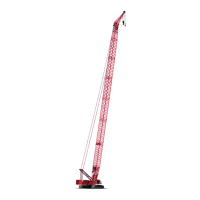HYDRAULIC SYSTEM 16000 SERVICE/MAINTENANCE MANUAL
2-16
Published 05-03-17, Control # 228-03
3. When the controls are off, the cylinders must not retract.
If they do, contact the Manitowoc Crane Care Lattice
Team.
4. When retracting the jacks, the carbody must lower
slowly and smoothly.
Crawler Pins
Perform the following procedure prior to connecting the
crawlers to the carbody:
1. Remove the collars from the ends of the pins.
2. Fully engage and disengage the pins three to four times
to remove air from the cylinders.
3. Scroll to the pins diagnostic screen to verify that 206 bar
(2,989 psi) is present when the pins are fully engaged
and disengaged (stalled).
Counterweight Pins
Perform the following procedure after the hydraulic lines are
connected to the cylinders just prior to lifting the
counterweight tray into position at the rear of rotating bed:
1. Fully engage and disengage the pins three to four times
to remove air from the cylinders.
2. Scroll to the pins diagnostic screen to verify that 206 bar
(2,989 psi) is present when the pins are fully engaged
and disengaged (stalled).
Boom Hinge Pins
Perform the following procedure after hydraulic lines from the
butt are connected to the crane just prior to aligning the
boom butt with the rotating bed:
1. Fully engage and disengage pins three to four times to
remove air from cylinders.
2. Scroll to pins diagnostic screen to verify that 206 bar
(2,989 psi) is present when pins are fully engaged and
disengaged (stalled).
Cab Tilt
To verify cab tilt operation, use the following procedure:
1. Fully raise and lower the cab three to four times to
remove air from the cylinders (use the switch in the cab).
2. Scroll to the cab tilt diagnostic screen to verify that 206
bar (2,989 psi) is present when the cylinders are fully
engaged and disengaged (stalled).
3. With control off, the cylinders must not retract. If they do,
contact the Manitowoc Crane Care Lattice Team.
4. When lowering the cab, it must lower slowly and
smoothly. If necessary adjust the cab tilt flow meters as
described in this section.
Rigging Winch (Optional)
To verify wench operation, use the following procedure:
1. Enable the rigging winch (see instructions in Section 3 of
16000 Operator Manual).
2. Operate the winch several times in both directions to
make sure it is operating properly and to remove air from
the system.
3. Scroll to the cab tilt, rigging winch, and mast diagnostic
screen to verify that 206 bar (2,989 psi) is present when
operating the winch.
Low Pressure Accessory System
A pressure reducing valve limits pressure in the low pressure
accessory system to the value specified in Table 2-10
.
The low pressure accessory system controls the swing
brake, travel brake, travel 2-speed, diverting valves, and
boom hoist pawl.
Swing Brake
Perform the following check in an area where the crane can
be swung without interference:
1. Scroll to the swing diagnostic screen to monitor the
swing component icons.
2. Turn off the swing park and attempt to swing the crane
by moving the control handle in both directions.
3. The crane must swing freely.
4. The swing screen should indicate that the swing park
brake is released and the swing brake pressure sensor
will report to Node-5 the hydraulic pressure at the swing
brake.
5. Bring the upperworks to a complete stop, move the
control handle to off, and turn on the swing park.
6. The swing handle should be inoperable.
7. The swing screen should indicate no handle or pump
commands and that the swing park brake is applied.
Travel Brakes
Perform the following check in an area where the crane can
be traveled without interference:
1. Scroll to the travel diagnostic screen to monitor the
travel component icons.
2. Turn off the travel park and attempt to travel the crane by
moving the control handles in both directions.
3. The crane must travel freely.
4. The travel screen should indicate that the travel park
brakes are released.

